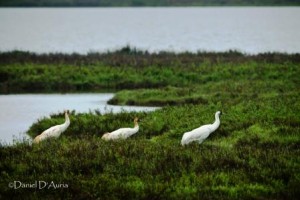Whooping Crane Update –Aransas Refuge, U.S. Fish and Wildlife Service, March 29, 2012
Precipitation/Salinity:
As of March 28, the monthly precipitation totals for Aransas National Wildlife Refuge are 2.41 inches and salinity levels in San Antonio Bay are recorded as 19.7 parts per thousand. With salinity levels below 20 parts per thousand, conditions in the marsh continue to normalize and food production for the birds improves. Even so, the refuge is still not to pre-drought conditions and biologists remain concerned. Photo by Daniel D’Auria
Food Sources:
Since the last update, the refuge has completed all of the prescribed burns for the season. The changing weather makes it difficult to safely and effectively conduct any more. The refuge was able to burn a total of 12,310 acres of habitat, areas targeted because of their value to whooping crane food source.
Reports:
The refuge is still waiting on the final report from the second carcass (recovered January 18). The third carcass (recovered February 29, 2012) was examined by the National Wildlife Health Center in Madison, WI. Results from this necropsy were inconclusive due to the extensive scavenging that had occurred to the carcass. However, bone marrow was found to contain
several bacteria strains.
The refuge will issue a final ‘State of the Cranes’ report summarizing the significant events that occurred during the 2011-12 whooping crane season.
Surveys:
Biologists hope to get in one last flight before the change in weather makes it too difficult. A flight is scheduled for today, Thursday March 29th. Analysis of data collected from previous surveys is still ongoing and will be presented in the annual report provided by the refuge.
Radio-marked birds and sightings of cranes from the flyway indicate the birds have begun their northern migration back to Wood Buffalo National Park in the Northwest Territories of Canada where they nest exclusively.
Supplemental Feeding:
The refuge continues to get questions regarding supplemental feeding. At this time, the refuge is concerned about the negative impacts of supplemental feeding. Previous efforts to supplemental feed were not considered successful as only a small portion of the birds actually fed on the shelled corn. Whooping cranes are territorial and do not naturally gather together to feed. Encouraging them to do so changes their natural behavior; it also creates greater opportunities to transmit diseases, parasites, and makes them more vulnerable to predators. Furthermore, when left out in warm and moist environments, like coastal marsh
areas, corn can grow Aspergillis molds. Aflatoxins, which are produced by the molds, can be lethal to whooping cranes and other wildlife. Where whooping cranes may be present, landowners should be aware of the risks that aflatoxins pose. If corn is being used for feeding other wildlife in areas where whooping cranes may be present, we highly recommend purchasing aflatoxin-free corn.

